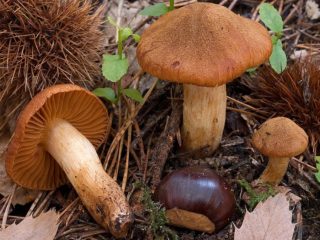Content
White-violet cobweb is a conditionally edible lamellar mushroom of the Cobweb family. It got its name because of the characteristic blanket on the surface of the spore-bearing layer.
What does a white-purple web spider look like?
A small, silvery mushroom with a faint chemical or fruity odor.
White-purple cobweb grows in small groups
Description of the cap
In a young mushroom, the cap has a rounded bell-shaped shape, then becomes convex and convexly spread with a raised blunt or wide tubercle. Diameter - from 4 to 8 cm. The surface is often uneven, shiny, silky-fibrous, sticky in rainy times.The color is initially lilac-silver or white-lilac; as it grows, the middle acquires a yellow-brown or ocher tint, then fades to a dirty white tone.
The plates have uneven edges, narrow, rather sparse, attached to the stem with a tooth. In young specimens they are grayish-bluish, gradually becoming bluish-ocher, then brownish-brown with light edges.
In mature specimens, the plates become brownish in color.
The color of the spore powder is rusty brown. The spores are small warty, ellipsoidal-almond shaped. Size – 8-10 X 5.5-6.5 microns.
The blanket is cobwebby, silvery-lilac, and as it grows it becomes dense, reddish, and then transparent-silky. It is attached to the stem quite low and is clearly visible in not too old specimens.
The color of the pulp is bluish, whitish, pale lilac, lilac.
Description of the leg
The leg is club-shaped, solid, sometimes curved, with one or more whitish, rusty bands, sometimes disappearing. The surface is matte, the color is whitish-silky with a violet, lilac or bluish tint, the color is more intense at the top. Below the belt with mucus. The flesh is lilac. Leg height – from 6 to 10 cm, diameter – from 1 to 2 cm.
A characteristic feature of all cobwebs is a blanket on the spore-bearing layer, descending along the stalk
Where and how does it grow
Settles in open woodlands, deciduous and coniferous forests. Prefers the proximity of birch and oak. Loves moist soils. Found in small groups or singly. Forms mycorrhiza with birch.
Distributed in many European countries, the USA, Morocco. In Russia it grows in the Primorsky and Krasnoyarsk territories, Tatarstan, Tomsk, Yaroslavl regions, and Buryatia.
Is the mushroom edible or not?
White-violet cobweb is a conditionally edible mushroom. Suitable for consumption after boiling for 15 minutes, as well as salted and pickled. Gastronomic quality is low.
Doubles and their differences
Silver web spider distinguished by the absence of purple tints except on the flesh at the top of the stem. In some sources it is considered a variety of white-violet and according to descriptions it is practically no different from it. The mushroom is inedible.
The silver putinnik is almost no different in appearance from the white-violet one
Camphor cobweb has a similar appearance and color of the fruiting body. It is distinguished by brighter plates, dense pulp with lilac-brownish marbling on the cut, and a very unpleasant burnt odor. Grows in damp dark coniferous forests. Considered inedible and poisonous.
The camphor type is distinguished by marbled pulp
Goat's web has a very unpleasant smell. Differs from white-violet in rusty plates, a more intense purple color, and a dry surface. It is classified as inedible and poisonous.
A distinctive feature of this mushroom is its “goat” smell.
The web spider is excellent. The cap is hemispherical, velvety, purple in young specimens, red-brown in mature specimens. The leg is pale purple, with remnants of a spathe. It is classified as conditionally edible and has a pleasant smell and taste. Not found in Russia. In some European countries it is included in the Red Book.
The excellent web spider has a dark cap
Conclusion
White-purple cobweb is a fairly common mushroom.Grows in forests of any type where there are birch trees.















